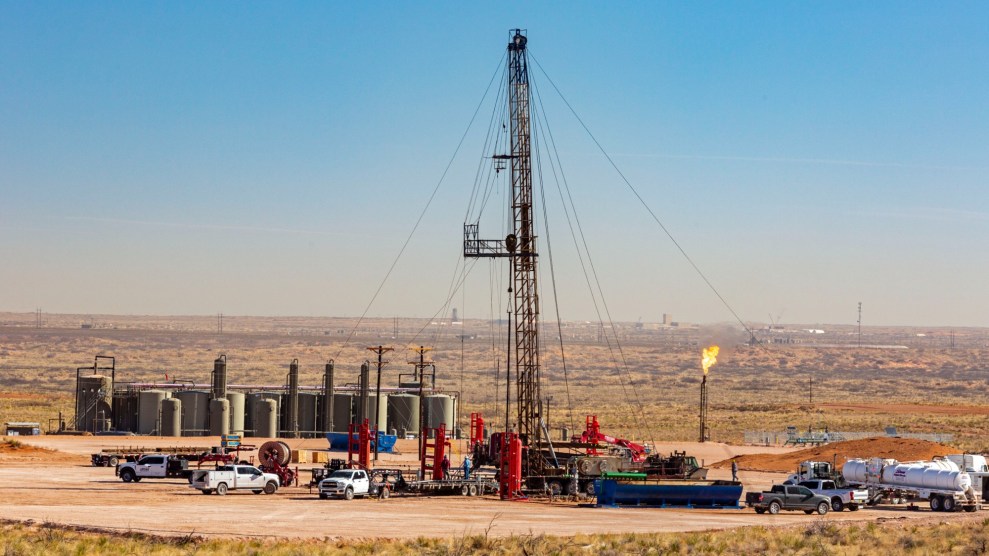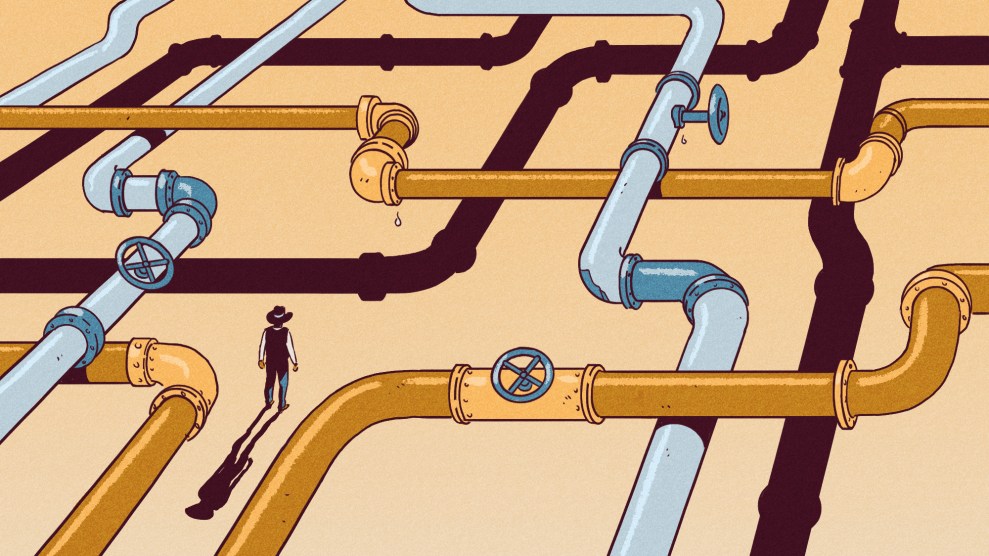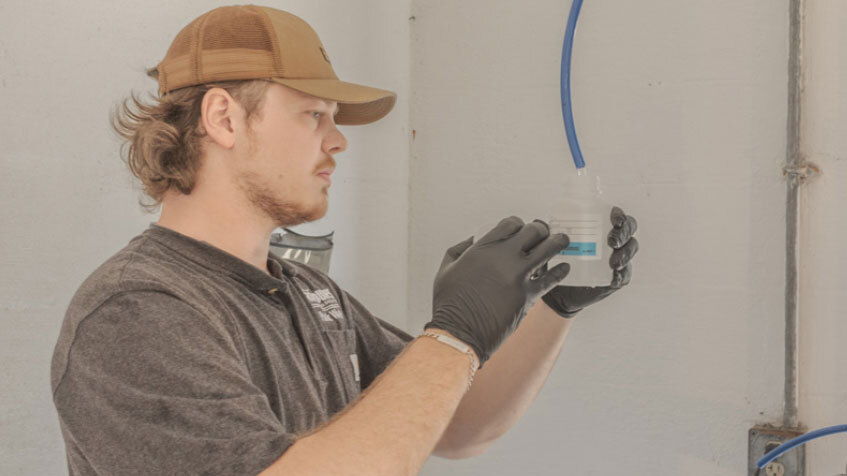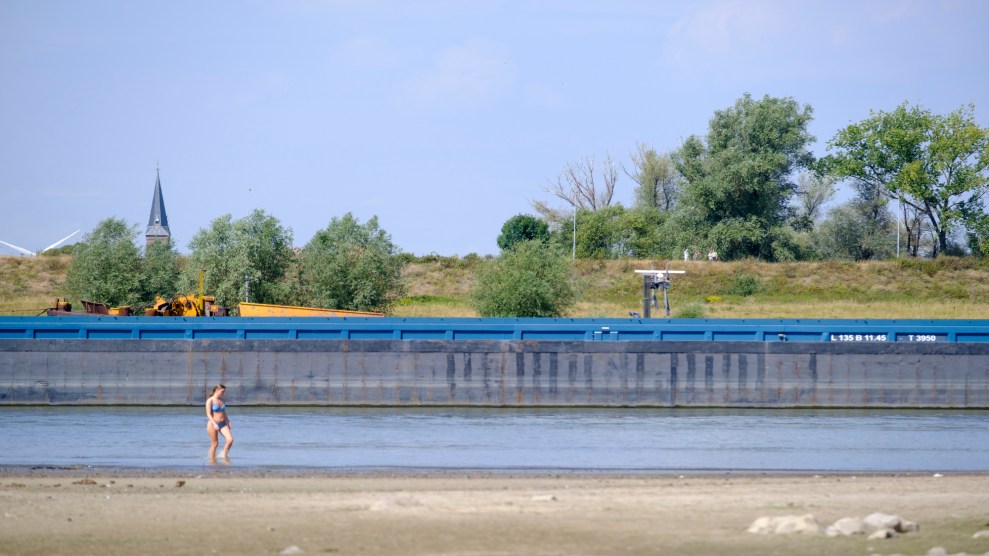
An oil drilling rig and oil storage tanks in Loving, New Mexico.Jim West/Zuma
This story was originally published by Inside Climate News and is reproduced here as part of the Climate Desk collaboration.
New Mexico will invest $500 million into purchasing water from controversial sources, including treated oilfield wastewater, as a means to bolster the state’s water portfolio. The purchases are the latest in a long-running series of deals dipping into untapped waters to shore up dwindling supplies as climate change and decades of overconsumption drive aridification of the Southwest.
The water would come from two sources: brackish saltwater, from aquifers deep underground, and produced water—wastewater from oil and gas wells. Neither source, but particularly the latter, is immediately fit for most consumptive purposes. But as traditional water supplies like rivers and groundwater aquifers are depleted in the Southwest, local and state governments are increasingly investing in new water sources to keep up economic and population growth, despite skepticism from environmentalists and water experts.
“In arid states like ours, every drop counts. A warming climate throws that fact into sharper relief every day,” said Gov. Michelle Lujan Grisham in a press release Tuesday. “This is innovation in action: We’re leveraging the private sector to strengthen our climate resiliency and protect our precious freshwater resources.”
Critics are calling the plan a handout for the fossil fuel industry that will only incentivize further drilling for oil and gas in New Mexico, where the produced water comes from, driving increased emissions of greenhouse gases to further warm the climate and dry out the region.
“As her administration is rubber stamping new permits for oil and gas emissions that increase climate stress and water scarcity, she is then going to spend $500 million on the industry’s wastewater to treat the water scarcity issue that is caused by their climate emissions,” said Melissa Troutman, a climate and energy advocate with WildEarth Guardians, an environmental nonprofit advocating for reforms of New Mexico’s oil and gas regulations.
Fresh water is becoming increasingly scarce in New Mexico. In August 2022, the Rio Grande went dry in Albuquerque for the first time in four decades and tensions are rising between the U.S. and Mexico over water availability. New Mexico also gets water from the dwindling Colorado River, and is one of the states engaged in tense, ongoing negotiations over how to preserve the system that provides fresh water to 40 million people in the region and supports the region’s vital agricultural production. On top of it all, the water from nearly every aquifer in the state is already completely allocated.
That’s left Southwestern states searching for new water supplies, with cities and states turning to desalination, complex water transfer agreements, recycling wastewater for consumption and more to try and diversify water portfolios. But strong skepticism remains over the use of brackish and produced water. Produced water from oil and gas drilling, not only comes from the industry primarily responsible for greenhouse gas emissions driving climate change, but can be filled with a variety of toxic chemicals.
Treating produced water to standards suitable even for industrial use could be pricey, critics say, and those funds could be better spent on other solutions to the state’s water scarcity. It’s a sentiment shared by environmentalists in Texas, New Mexico’s neighbor, which proposed similar legislation earlier this year. “I’m very skeptical,” said Bruce Thomson, professor emeritus in civil engineering at the University of New Mexico who previously ran the Water Resources Program there.
Little is known about the hydrology of the deep underground aquifers the water is held in, he said, and most of the basins are not rechargeable, meaning once it’s gone, it’s gone forever. He also noted the chemistry of the water makes it difficult to desalinate and can even feature hazardous waste left over after desalination.
And unlike desalinating ocean water, which can put the brine left behind by the process back in the sea, there is no easy place to put the leftover brine from desalination projects in landlocked, arid lands like New Mexico.
For produced water, all of the problems of brackish water are significantly worse and more complicated due to its toxicity and extreme salinity—typically three to four times that of ocean water, Thomson said. Neither is a real solution to the region’s increasing aridity, he said, and ultimately, New Mexico and the Southwest as a whole, will have to make the most of its dwindling water supply. “There is no new water,” he said.
But that doesn’t mean states like New Mexico won’t try to find new supplies.
Beginning next year, the New Mexico Environment Department will begin seeking proposals from companies interested in providing brackish or produced water. The contracts will come in the form of advanced market commitments, which allows companies to seek investments from the private sector, such as to build treatment facilities, with a guarantee the state will buy the water.
That water will largely be used for industrial purposes, like the development of hydrogen, solar and wind farms, and the manufacturing of goods like microchips, though it has the potential to be used for other purposes “as treatment and demand allow,” the state said.
Lujan Grisham, who made the announcement at COP28 in Dubai, told Reuters the brackish water could be used eventually for public consumption, while the produced water, which is far more toxic, would be reserved for clean energy development.
Those industries, however, can be water-intensive. The development of hydrogen fuel, for instance, requires water to be treated to higher standards than for drinking.
The use of water not typically utilized for irrigation or drinking to support these industries could help save more higher-quality freshwater from being tapped for uses that don’t need it. But as resources dwindle, water experts have said even water better suited for industrial need may be required for residential use as long as it meets drinking standards.
“This is just another example of throwing money at a technological, so-called fix to a problem that requires comprehensive planning and addressing systemic issues,” Troutman said.















